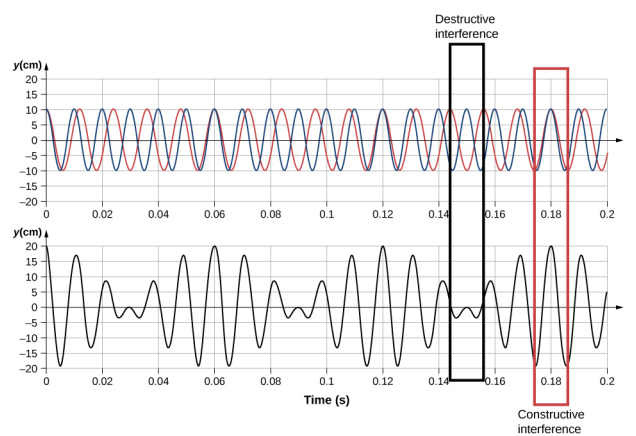11.11: Beats
( \newcommand{\kernel}{\mathrm{null}\,}\)
- Determine the beat frequency produced by two sound waves that differ in frequency
- Describe how beats are produced by musical instruments
The study of music provides many examples of the superposition of waves and the constructive and destructive interference that occurs. Very few examples of music being performed consist of a single source playing a single frequency for an extended period of time. You will probably agree that a single frequency of sound for an extended period might be boring to the point of irritation, similar to the unwanted drone of an aircraft engine or a loud fan. Music is pleasant and interesting due to mixing the changing frequencies of various instruments and voices.
An interesting phenomenon that occurs due to the constructive and destructive interference of two or more frequencies of sound is the phenomenon of beats. If two sounds differ in frequencies, the sound waves can be modeled as
y1=Acos(k1x−2πf1t)
and
y2=Acos(k2x−2πf2t).
Using the trigonometric identity
cosu+cosv=2cos(u+v2)cos(u−v2)
and considering the point in space as x=0.0m, we find the resulting sound at a point in space, from the superposition of the two sound waves, is equal to Figure 11.11.1:
y(t;x=0m)=2Acos(2πfavgt)cos[2π(|f2−f1|2)t],
where the beat frequency is
fbeat=|f2−f1|.

These beats can be used by piano tuners to tune a piano. A tuning fork is struck and a note is played on the piano. As the piano tuner tunes the string, the beats have a lower frequency as the frequency of the note played approaches the frequency of the tuning fork.
What is the beat frequency produced when a tuning fork of a frequency of 256 Hz and a tuning fork of a frequency of 512 Hz are struck simultaneously? Strategy The beat frequency is the difference of the two frequencies.
Solution
We use Equation ??? to get the beat frequency
fbeat=|f2−f1|=(512−256)Hz=256Hz.
Significance
The beat frequency is the absolute value of the difference between the two frequencies. A negative frequency would not make sense.
What would happen if more than two frequencies interacted? Consider three frequencies.
The study of the superposition of various waves has many interesting applications beyond the study of sound. In later sections, we will discuss the wave properties of particles. The particles can be modeled as a “wave packet” that results from the superposition of various waves, where the particle moves at the “group velocity” of the wave packet.


